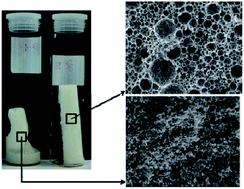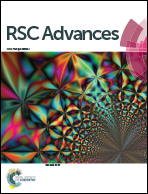Non-aqueous high internal phase emulsion templates for synthesis of macroporous polymers in situ filled with cyclic carbonate electrolytes†
Abstract
In order to develop inks suitable for roll-to-roll printing processes, which can be cured into in situ electrolyte filled high porosity macroporous polymer membranes, non-aqueous high internal phase emulsions (HIPEs) were prepared. The external phase of the formulated HIPEs consisted of lauryl methacrylate (LMA) and 1,14-tetradecanediol dimethacrylate (TDDMA) while a solution of bis(trifluoromethane)sulfonimide lithium salt (LiTFSI) in a mixture of ethylene (EC) and propylene carbonate (PC) served as the internal phase. The stability of these non-aqueous HIPEs was strongly affected by the surfactant and the LiTFSI concentration in the internal phase. HIPE templates could only be polymerised when the LiTFSI concentration varied between 0.06 and 0.8 mol l−1. Electrochemical, thermal properties as well as morphology of the resulting polyHIPEs are discussed with respect to HIPE composition. The ionic conductivity of the resulting polyHIPEs was measured to be in the range from 4.18 to 8.64 mS cm−1.


 Please wait while we load your content...
Please wait while we load your content...